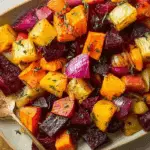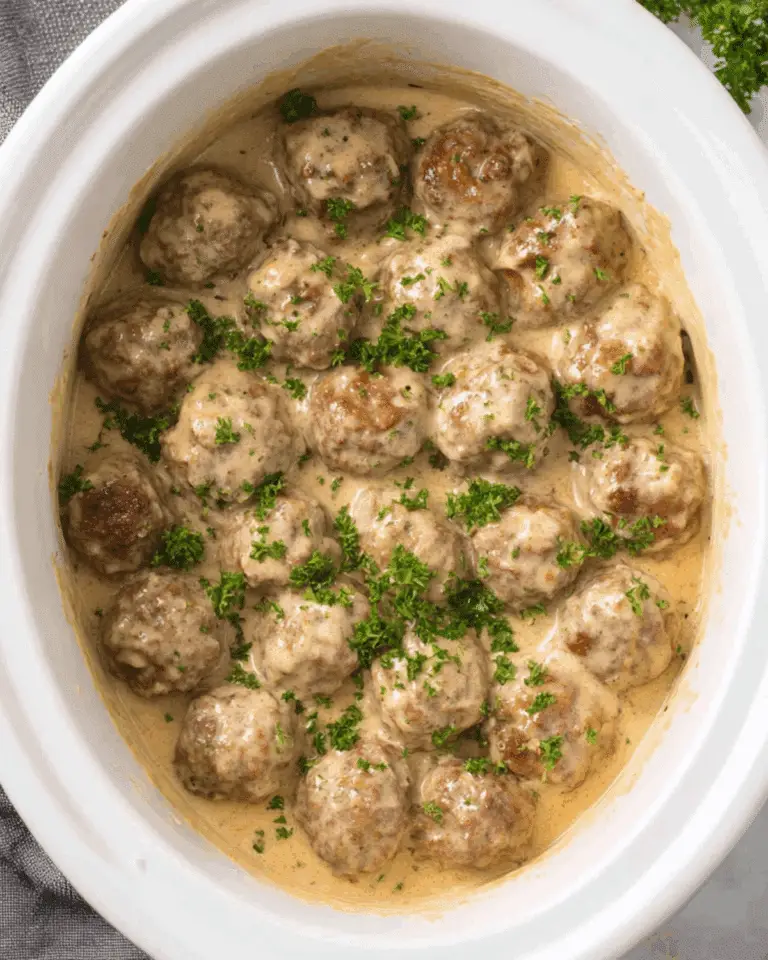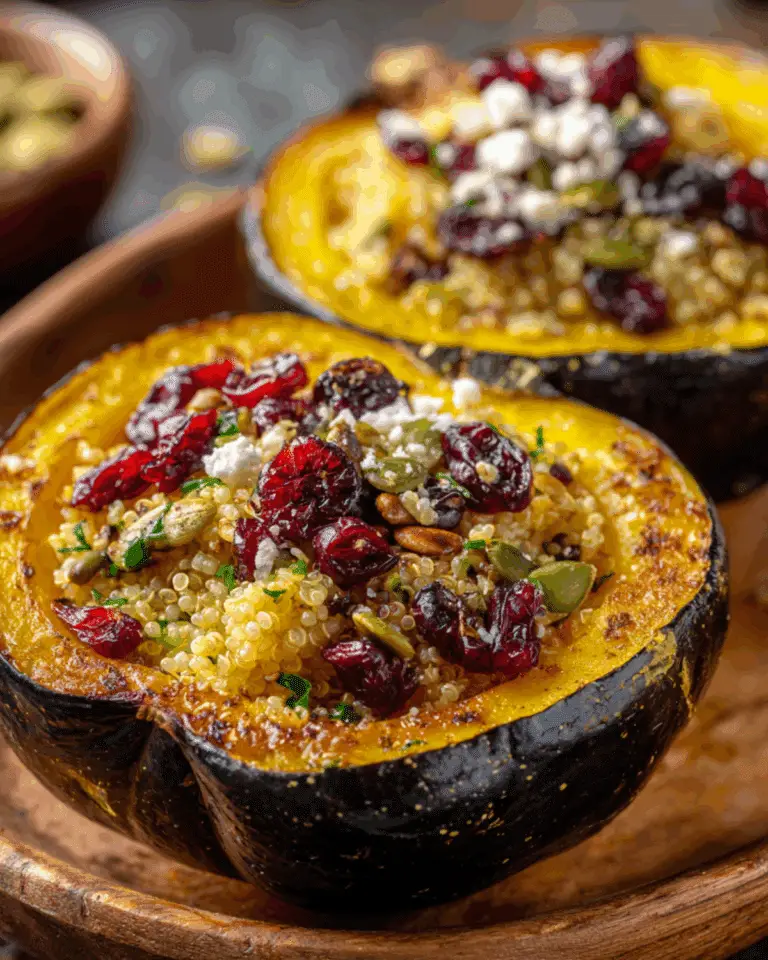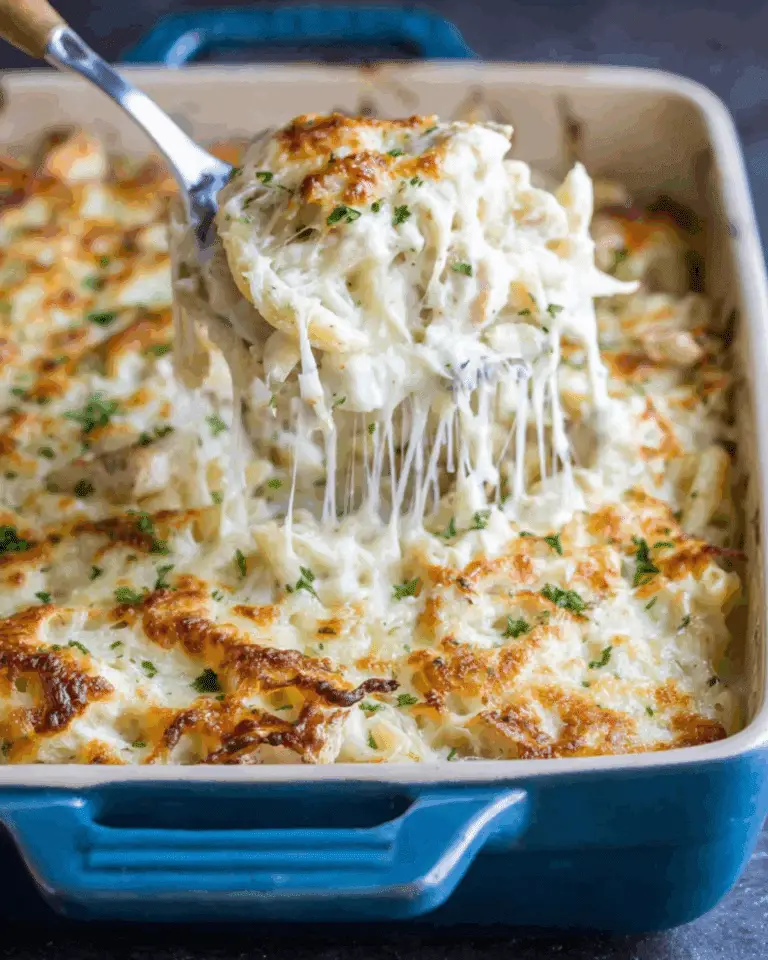Roasting root vegetables is one of the easiest and most flavorful ways to enjoy the season’s bounty. This guide will show you exactly how to roast root veggies for crispy edges, caramelized sweetness, and fork-tender centers. From choosing the best produce to mastering the oven techniques, you’ll learn everything to perfect this wholesome side dish. Plus, we’ll cover seasoning combos, common mistakes to avoid, and serving ideas to make your meal shine.
Looking for inspiration? Try this cozy idea: Roasted Acorn Squash Treat for another fall favorite.
JUMP TO
Table of Contents
The Magic of Roasting Root Vegetables
Why Roast Root Vegetables?
Roasting root vegetables isn’t just a cooking method—it’s a flavor transformation. High heat draws out the natural sugars in carrots, parsnips, beets, and potatoes, leaving them beautifully caramelized and full of earthy sweetness. Compared to steaming or boiling, roasting adds both texture and rich depth of flavor, making veggies the star of any plate.
Benefits of Root Veggies in Your Diet
Root vegetables are nutrient-dense powerhouses. Packed with dietary fiber, complex carbs, and essential vitamins like A, C, and K, they fuel your body while keeping you full. Sweet potatoes are loaded with beta-carotene, while beets boast natural nitrates for heart health. Eating a rainbow of roots is not only delicious—it’s good for you too.
Seasonal Favorites for Maximum Flavor
For the best results, choose veggies that are in season. Fall and winter bring out the boldest flavors in:
- Carrots
- Parsnips
- Sweet potatoes
- Beets
- Turnips
- Rutabagas
- Red potatoes
- Celery root (celeriac)
These root veggies roast beautifully and pair well together due to similar cook times and sugar content.
Choosing and Prepping the Right Root Vegetables
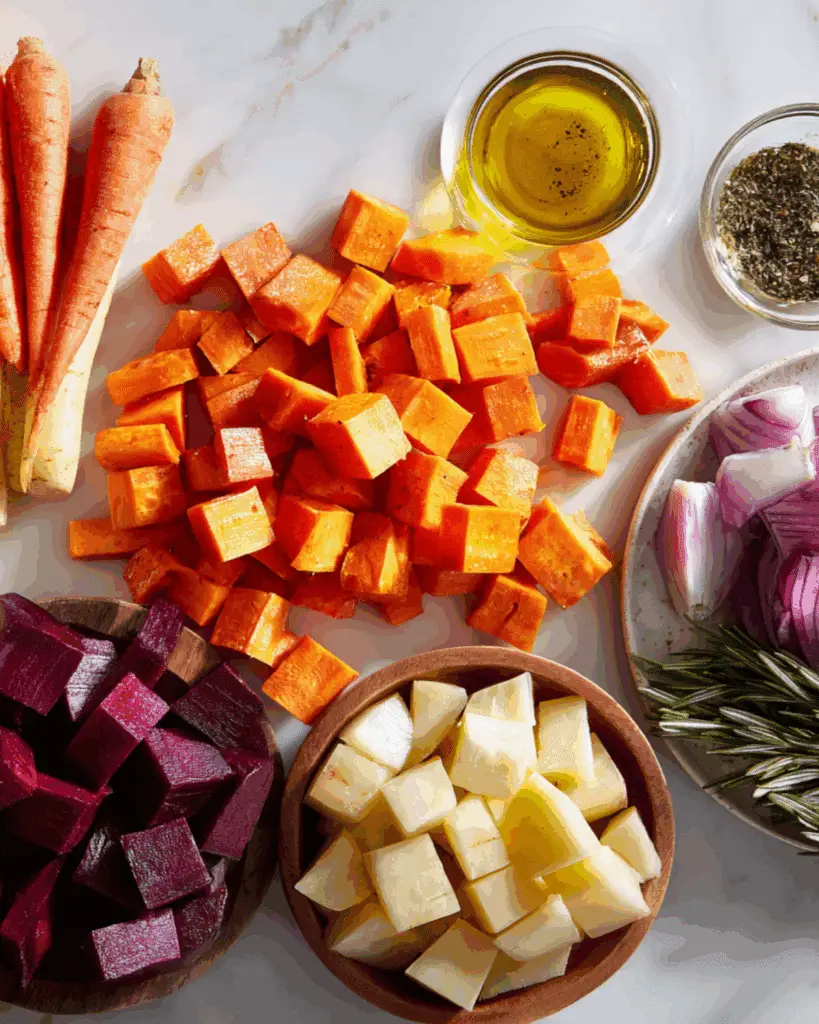
Best Root Vegetables for Roasting
If you’re building a sheet pan of roasted roots, variety is key. Combine sweet and savory elements for balance. Here’s a quick chart to help you choose:
| Vegetable | Flavor Profile | Roast Temp | Avg. Time |
|---|---|---|---|
| Carrots | Sweet, earthy | 425°F | 25–35 min |
| Beets | Earthy, sweet | 400°F | 35–45 min |
| Parsnips | Nutty, sweet | 425°F | 25–30 min |
| Sweet Potatoes | Creamy, sweet | 400°F | 30–40 min |
| Potatoes | Starchy, neutral | 425°F | 35–40 min |
Mix and match based on taste and texture. Keep denser roots in smaller cuts to ensure even roasting.
How to Prep Root Veggies for Even Cooking
Preparation makes all the difference in texture and doneness. Follow these tips:
- Wash thoroughly to remove dirt and grit.
- Peel only when necessary—some skins like carrots and potatoes are edible and tasty.
- Cut into uniform sizes to avoid overcooked or undercooked pieces.
- Soak potatoes in cold water for 30 minutes to remove excess starch for crispier results.
Don’t miss our Loaded Scalloped Potatoes Recipe for another potato-perfect idea!
Cutting Techniques for Crispiness and Caramelization
- Large dice (1–2 inches) gives you a crispy exterior and creamy inside.
- Wedges work great for sweet potatoes or beets.
- Julienne or matchsticks roast quickly and add texture to salads or bowls.
Avoid thin slices—they tend to burn or dry out fast. Use a sharp knife to prevent bruising.
Mastering the Roasting Process
Ideal Oven Temperature and Time
Most root vegetables roast best at 400°F to 425°F (200–220°C). High heat is critical for achieving that golden crust while keeping the centers soft.
- For mixed trays: 425°F for 30–40 minutes.
- Stir halfway through for even browning.
- Use convection mode if available for crispier edges.
Discover great ideas like this Easy Creamy Cheesy Potato Bake Recipe that pairs well with roasted veggies.
Best Oils and Seasonings for Roasting
Choosing the right oil ensures your veggies roast, not steam. Use oils with a high smoke point:
- Olive oil – classic flavor
- Avocado oil – high smoke point
- Ghee or duck fat – for a gourmet touch
Top seasonings include:
- Salt and freshly cracked pepper
- Garlic powder, onion powder
- Rosemary, thyme, or sage
- Smoked paprika or cumin for depth
Toss in a large bowl to coat every piece evenly.
Tips for Even Roasting Every Time
- Use a large baking sheet with space between pieces to avoid steaming.
- Don’t crowd the pan—airflow is key.
- Preheat your oven fully before baking.
- Line with parchment paper or foil for easy cleanup.
Looking for a salad to serve on the side? Check out this Shredded Brussels Sprouts Salad Method—a crunchy complement to any roasted veg dish.
Flavor Combinations and Variations
Herb and Spice Blends to Try
Roast root vegetables are a blank canvas for bold flavors. Depending on the meal, you can lean into earthy, spicy, or sweet notes. Try these blends for a boost:
- Mediterranean: rosemary, oregano, garlic, lemon zest
- Southwestern: cumin, chili powder, smoked paprika
- Sweet and Savory: cinnamon, nutmeg, maple syrup drizzle
- Indian-inspired: turmeric, curry powder, coriander
Don’t forget to finish with a splash of acid like balsamic vinegar or a squeeze of lemon after roasting—it brightens everything up!
Sweet vs. Savory Flavor Profiles
You can easily tailor your roast to match your dish:
Sweet Style
- Toss with honey, maple syrup, or brown sugar before roasting
- Add apples or cranberries for a festive touch
- Works beautifully for holiday sides
Savory Style
- Go heavy on garlic, rosemary, or thyme
- Add onions or shallots for deeper flavor
- Pairs well with meats and hearty mains
Looking for a seasonal salad to balance sweetness? Don’t miss our Wild Rice Salad Recipe for a hearty, nutty pairing.
Adding Proteins or Other Vegetables
You can upgrade this side dish into a full meal by tossing in proteins or complementary veggies:
- Chickpeas or lentils – add plant-based protein
- Chicken or sausage – roast together on one pan
- Brussels sprouts or cauliflower – for texture variety
- Kale or spinach – stir in during the last 5 minutes for wilted greens
Roast everything together using a two-zone setup: heavier veggies on one half, lighter ones on the other, adjusting cook times as needed.
Serving Ideas and Storage Tips
What to Serve With Roasted Root Vegetables
Roasted root vegetables are super versatile. They go with almost anything! Here are some pairing ideas:
- Roast chicken or turkey – a classic holiday match
- Pork tenderloin or beef roast – hearty and filling
- Grain bowls with quinoa or rice – for meal prep or lunch
- Fried eggs or tofu – easy breakfast or vegetarian option
For a deliciously simple side dish idea, explore our Creamy Roasted Garlic Butternut Squash Pasta recipe—it complements root veggies beautifully.
How to Store Leftovers
Roasted vegetables keep well when stored properly:
- Fridge: Store in an airtight container for up to 4–5 days
- Freezer: Flash freeze on a sheet pan, then transfer to bags; best used within 2 months
- Meal prep tip: Separate by veggie type if you want more control over reheat times
Label your containers with the date, and try to use glass containers for better freshness.
Best Ways to Reheat Without Losing Texture
To keep your veggies crispy when reheating:
- Oven: 375°F for 10–15 minutes, uncovered
- Air fryer: 350°F for 5–7 minutes
- Skillet: Use a hot pan with a little oil to crisp the edges
Avoid microwaving if you can—it tends to steam them and ruin the crisp.
Common Mistakes to Avoid
Overcrowding the Pan
This is probably the most common error. If your veggies are too close together, they’ll steam instead of roast. Always use a large enough sheet pan and leave space between each piece.
Consider roasting in batches if you’re making a big serving.
Skipping the Oil or Not Seasoning Enough
Oil helps conduct heat and promotes browning. No oil = dry and limp vegetables. Use about 1–2 tablespoons per pound of veggies and toss evenly. Don’t be shy with the salt, either—it brings out the sweetness in root vegetables.
Using the Wrong Pan or Temperature
Glass and ceramic pans don’t crisp up the veggies as well as metal baking sheets. Also, if you roast below 375°F, you’ll miss that caramelization magic. Stick to 400–425°F and preheat your oven fully.
Avoid stacking veggies or using deep dishes unless you’re braising.
Frequently Asked Questions (FAQ)
What root vegetables roast the fastest?
Carrots, parsnips, and sweet potatoes tend to roast faster than denser vegetables like beets or turnips. Cutting them into smaller pieces helps speed up cooking. Roasting time also depends on the oven temperature and how crowded your pan is.
Do you need to peel root vegetables before roasting?
Not always. Veggies like carrots and potatoes have edible skins that become crispy and flavorful when roasted. However, tougher skins on rutabagas or celery root are best peeled for a better texture. Always scrub well if you’re keeping the peel.
Can you roast frozen root vegetables?
Yes, but they may not get as crispy as fresh ones. To improve texture, thaw them first, pat dry with a paper towel, and roast at a slightly higher temperature (around 450°F). Toss with oil and seasonings for flavor.
How do you keep roasted vegetables from getting soggy?
Soggy roasted veggies are often the result of overcrowding or not enough oil. Use a large, rimmed baking sheet with space between each piece. Roast at high heat and avoid using too much moisture or sauce until after they’re cooked.
Conclusion: Your New Favorite Side Dish
Roasted root vegetables are as simple as they are stunning. With the right selection of produce, proper prep, and a hot oven, you’ll get rich, caramelized flavor in every bite. Whether you keep it classic or jazz it up with bold seasonings and add-ins, this dish delivers comfort, nutrition, and satisfaction every time.
Looking for another cozy side idea? Check out our Loaded Scalloped Potatoes for a hearty pairing.
PrintRoast Root Vegetables
Learn how to roast root vegetables perfectly with this easy, flavorful oven recipe. Get crispy, caramelized veggies every time with simple prep, seasoning tips, and roasting techniques.
- Prep Time: 15 minutes
- Cook Time: 35 minutes
- Total Time: 50 minutes
- Yield: 4 servings
- Category: Side Dish
- Method: Roasting
- Cuisine: American
- Diet: Vegan
Ingredients
- 2 cups carrots, peeled and chopped
- 2 cups sweet potatoes, peeled and cubed
- 1 cup parsnips, peeled and chopped
- 1 cup beets, peeled and cubed
- 2 tbsp olive oil (or avocado oil)
- 1 tsp sea salt
- 1/2 tsp black pepper
- 1 tsp dried rosemary or thyme
- 1/2 tsp garlic powder (optional)
Instructions
- Preheat oven to 425°F (220°C).
- Wash, peel (if needed), and chop all root vegetables into uniform sizes for even roasting.
- In a large bowl, toss the vegetables with olive oil, salt, pepper, and desired herbs/spices until evenly coated.
- Spread vegetables in a single layer on a large baking sheet lined with parchment paper.
- Roast for 30–40 minutes, stirring halfway through, until vegetables are golden brown and tender.
- Optional: Drizzle with balsamic vinegar or lemon juice before serving for extra brightness.
Notes
- Cut vegetables to similar sizes to avoid uneven cooking.
- Use a metal baking sheet for better crisping.
- Don’t overcrowd the pan—use two sheets if needed.
- Store leftovers in an airtight container in the fridge for up to 5 days.
- Reheat in oven or air fryer to maintain texture.
Nutrition
- Serving Size: 1 cup
- Calories: 180
- Sugar: 7g
- Sodium: 320mg
- Fat: 7g
- Saturated Fat: 1g
- Unsaturated Fat: 6g
- Trans Fat: 0g
- Carbohydrates: 28g
- Fiber: 6g
- Protein: 2g
- Cholesterol: 0mg


